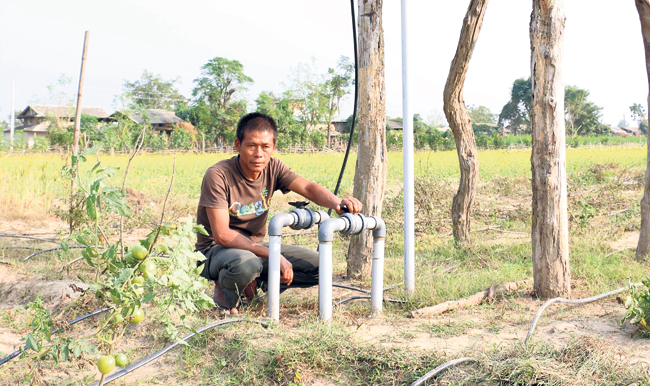Jagat Bahadur Shrestha, a farmer by profession, lives in Bijaya basti village in Nepal’s Parsa district. He and his family of five survive on less than a hectare of land from which they eke out a living. Water shortage is characteristic of Parsa district with many villagers abandoning farming of seasonal crops and opting for tobacco as the prime alternative given its need for less water.
“There used to be a river long time ago that passed through this village but it has dried up. All we had as a water source was a well that could hardly support 40 of the 300 households in our village. We had to wait for hours for our turn to get water, and sometimes we had to return with empty vessels. Being a farmer I always dreamt of planting vegetables that would give me a good income and meet the nutritional needs of my family, but I could neither grow my own vegetables nor buy them regularly,” said Shrestha.
In neighboring Bara district, Kanchi Maya Dhalan grappled with a similar problem. A residence of Ratanpuri village, Kanchi Maya relied on water from a small gorge for farming to support her family of eight.While the water from this source was adequate for her needs, the problem was having to walk to the source and back for water.She and the rest of the villagers lacked the resource as well to channel the water to their lands.
These villages in Parsa and Bara districts fall within Nepal’s fragile Churia region – the outermost hill range spreading from the east to the west of Nepal. Inhabited mostly by farmers, the ecology of the region is under constant pressure from deforestation, over-grazing, land conversion, inappropriate agricultural practices, and encroachment. The primary impact is on water availability and sustainable land management thereby directly affecting the livelihoods of local people such as Shrestha and Dhalan.
Chicken meat prices drop nationwide


Until two years ago, Shrestha, like his fellow villagers, had planted tobacco in his farmland. His annual harvest provided him with an income of Rs 10,000 (USD 100) which was insufficient to cover his household expenses, especially to afford his children’s education for which he used to take loans.
Dhalan, on the other hand, was relatively a little better off with an annual farming income of Rs 25,000 (USD 250). However, she had her own set of problems as water from the gorge contained significant amount of sand which was deteriorating the fertility of her land, and the rainfall was also erratic.
For Shrestha and Dhalan, whose lives were bound by a common concern, there was an urgent need for change.
In 2013, World Wildlife Fund (WWF) with the support of the Global Environment Facility (GEF) introduced a project Sustainable Land Management in the Churia region in Makawanpur, Parsa, Bara and Rautahat districts of central Nepal. The project also brought together for the first time four ministries of Nepal –Ministry of Land Reform and Management, Ministry of Forests and Soil Conservation, Ministry of Agricultural Development and Ministry of Science, Technology and Environment – under a common objective.
Within a short span of three years, the project brought about tangible benefits for the local people such as Shrestha and Dhalan.
In Parsa, Shrestha along with 11 households of Nirmal basti were supported with micro-irrigation facilities for the efficient use of water for irrigation in extremely dry areas. Shrestha participated in a training program on micro-irrigation techniques and agricultural practices and received equipment for a drip irrigation system in his farmland. This system helped Shrestha use the available water resource efficiently. Through the same source that he used in the past, Shrestha could now harvest seasonal crops thrice a year. His household income grew exponentially with earnings of around Rs 90,000 per annum. As an added benefit the micro irrigation system also aided in increasing the productivity of the soil.
In Bara, Dhalan and 11 other households from her village benefitted from a plastic pond that was constructed under the project which provided them continuous access to water for irrigation. Through technical support received from the project the local people conserved a natural spring source which became the main source of water supply for the plastic pond.The water from the spring source was then channelized to the plastic pond through an irrigation canal. With water now readily available close to her farmland, Dhalan now grows vegetables throughout the year. She now earns Rs 80 – 90,000 annually from farming. Showing her gold earring, Dhalan ecstatically said, “I bought them last year from my income from selling vegetables.”
For people like Shrestha and Dhalan, the best thing is that there have been sustainable changes in their lives. With a focus on local relevance, blending local knowledge with improved science and technology, the sustainable land management project in Churia has uplifted the condition of the local community giving the residents there a shot at a better life.
The writer is Senior Communications Officer at WWF Nepal.



































